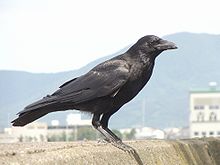Bird intelligence
The difficulty of defining or measuring intelligence in non-human animals makes the subject difficult to study scientifically in birds.Birds in the crow family (corvids) as well as parrots (psittacines) have been shown to live socially, have long developmental periods, and possess large forebrains, all of which have been hypothesized to allow for greater cognitive abilities.[2] Researchers need to be cautious, however, and ensure that birds are not merely demonstrating the ability to subitize, or count a small number of items quickly.E.H. Hoh wrote in Natural History magazine: In the 1970s, on the Li River, Pamela Egremont observed fishermen who allowed the birds to eat every eighth fish they caught.Writing in the Biological Journal of the Linnean Society, she reported that, once their quota of seven fish was filled, the birds "stubbornly refuse to move again until their neck ring is loosened.Visual or auditory signals and their association with food and other rewards have been well studied, and birds have been trained to recognize and distinguish complex shapes.In avian research, performance on simple associative learning tasks can be used to assess how cognitive abilities vary with experimental measures.Opposite results were found by Guido et al.,[13] who showed that neophobia in Milvago chimango, a bird of prey native to South America, negatively correlated to reversal learning.The researchers suggested a modern explanation for this discrepancy: since birds living near urban areas benefit from being less neophobic to feed on human resources (such as detritus), but also benefit from being flexible learners (since human activity fluctuates), perhaps low neophobia coevolved with high reversal learning ability.According to their study, low baseline levels of corticosterone (CORT), a hormone involved in stress response, predicted better associative learning.[14] The researchers showed that high-diet treatment was associated with larger head width, tarsus length, and body mass in the treated males.[14] In subsequent testing, researchers showed that high-diet and larger head-to-tarsus ratio correlated with better performance on an associative learning task.[15] Contradicting results by Kriengwatana et al.[16] found that low food diet in zebra finches prior to nutritional independence (that is, before the birds are able to feed themselves) enhanced spatial associative learning, impaired memory, and had no effect on neophobia.For the first phase of the experiment, the bird randomly searched for the reward between the seven sites, until it found it and was allowed to partially consume the food item.[18] Though it may seem universally beneficial to be a fast learner, Madden et al. suggested that the weight of individuals affected whether or not associative learning was adaptive.In their research, Veit et al. show that associative learning modified NCL (nidopallium caudolaterale) neuronal activity in crows.As the crows learned the associations through trial and error, NCL neurons showed increased selective activity for the rewarding stimulus.The researchers suggest that NCL neurons are involved in learning associations as well as making the subsequent behavioural choice for the rewarding stimulus.[21] In their study, nine individuals from five species of birds of prey learned to pair a neutral olfactory cue to a food reward.[22] Large fruit-eating birds in tropical forests depend on trees which bear fruit at different times of the year.[29] In 1981, Epstein, Lanza, and Skinner published a paper in the journal Science in which they argued that pigeons also pass the mirror test.[citation needed] Some studies have suggested that birds—separated from mammals by over 300 million years of independent evolution—have developed brains capable of primate-like consciousness through a process of convergent evolution.[31] The study acknowledges that similar neural circuitry does not by itself prove consciousness, but notes its consistency with suggestive evidence from experiments on birds' working and episodic memories, sense of object permanence, and theory of mind (both covered below).One proposed definition of tool use was defined by T. B. Jones and A. C. Kamil in 1973 as the use of physical objects other than the animal's own body or appendages as a means to extend the physical influence realized by the animal[32]By this definition, a bearded vulture (lammergeier) dropping a bone on a rock would not be using a tool since the rock cannot be seen as an extension of the body.While young birds in the wild normally learn this technique from elders, a laboratory crow named Betty improvised a hooked tool from a wire with no prior experience, the only known species other than humans to do so.[45] At the beginning of the 20th century, scientists argued that birds had hyper-developed basal ganglia, with tiny mammalian-like telencephalon structures.[49][50][51] The avian pallium's neuroarchitecture is reminiscent of the mammalian cerebral cortex,[52] and has been suggested to be an equivalent neural basis for consciousness.Dr. Harvey J. Karten, a neuroscientist at UCSD who has studied the physiology of birds, has discovered that the lower parts of avian brains are similar to those of humans.Social behavior requires individual identification, and most birds appear to be capable of recognizing mates, siblings, and young.[65][66] Macaws, carrion crows, and chickens have been demonstrated to fully comprehend the concept of object permanence at a young age.




brainsmammalcalls and songcorvidsravensmagpiespsittacinesparrotsmacawscockatoosPigeonsfinchesdomestic fowlbirds of preyCormorantssociallyforebrainssubitizeused by Chinese fishermenNatural History magazineLi RiverParasitic cuckoosAssociative learningcognitive abilitiesPavlovian conditioningFlorida scrub-jaysneophobiaMilvago chimangocoevolvedcorticosteronezebra finchestarsusmarsh titsjackdawsblue titsAustralian magpiescommon pheasantswestern scrub jaysday lengthEleonora cockatooSnowballbeat inductionmirror testconsciousMirror self-recognitionEuropean magpiesblack-bellied ploverconvergent evolutionlammergeierEgyptian vultureNew Caledonian crowspandanus treeswoodpecker finchEspañola cactus finchEastern carrion crowsCorvus coroneCarrion crowsAmerican crowsStriated heronsUniversity of BristolAvian palliumnidopalliumcorvinescerebral cortexconsciousnessgrey parrothigh vocal centersSocial animalfairy-wrenssuperbred-backednuptialvideo callsTalking birdscommunicatebody languageNew Zealand saddlebackIrene Pepperbergchickensobject permanenceA-not-B errorTheory of mindlittle green bee-eaterbrown-necked ravenCalifornia scrub jaycaches of foodhabitat destructionbehavioral plasticityextinction riskAnimal intelligencePigeon intelligenceEvolution of cognitionPig intelligenceOxford University PressAnimal CognitionBibcodeCiteSeerXWayback MachineHarvard University PressOutlineAnatomyFeathersFlightPreen glandPlumageVisionBehaviourSingingMigrationForagingSexual selectionLek matingSeabird breedingBrood parasitesNestingHybridsColonyEvolutionOrigin of birdsTheropodadinosaursOrigin of flightEvolution of birdsDarwin's finchesSeabirdsFossil birds